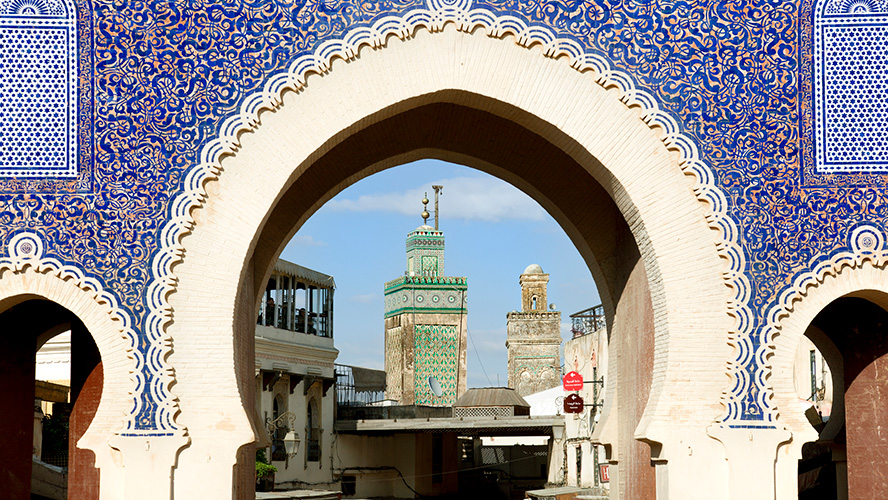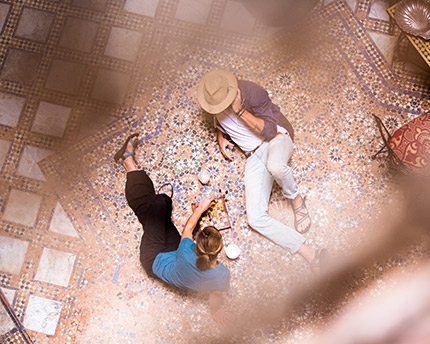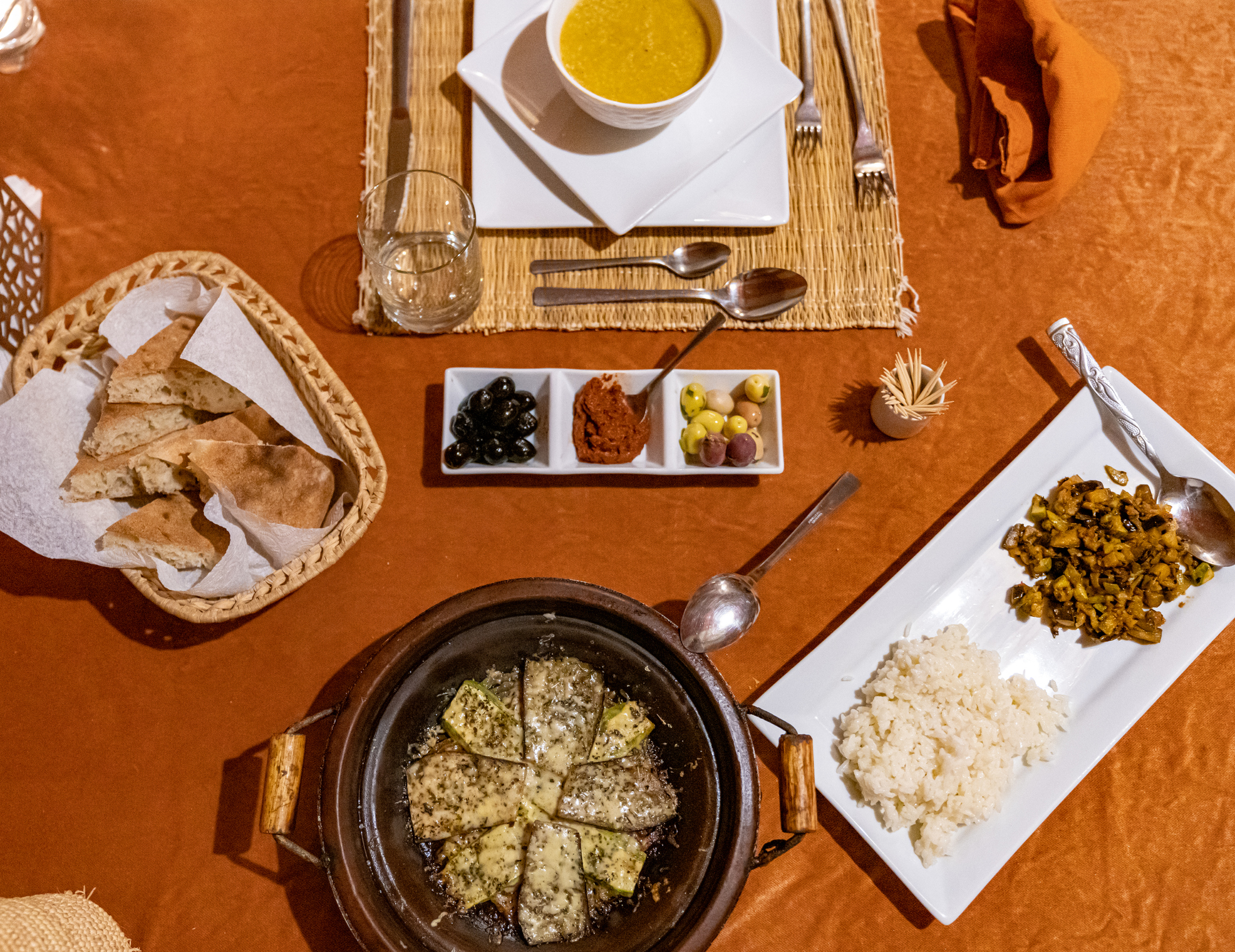Surrounded by nearly 20 kilometres of ramparts, the ancient Fez Medina is one of the most interesting and picturesque places not only in Morocco, but also in North Africa. A small universe of labyrinthine alleyways where you will find a bustling souk and the mausoleum of one of Morocco’s main historical figures; a tannery that still works as it did centuries ago; and one of the oldest educational institutions in the world. Bab Bou Jeloud, the Blue Gate, is its main entry point.
Threshold of the medina
Since its foundation in the 8th century, the heart of ancient Fez has been walled. A long and capricious line of thick rammed earth walls (“pisé” in French or “tabia” in Arabic) that has been lengthened and modified over time, in accordance with the constant expansion of the city and the contributions of its rulers (Idrisids, Almoravids, Almohads, Marinids, etc.). Obviously, the extensive wall has several access points (bab means gate in Arabic) from different periods and some are more monumental than others.
The oldest gates still standing, and historically the most important in the area of Fès el-Bali (the oldest part of the medina), are Bab Mahrouk (to the west), Bab Guissa (to the north-east) and Bab Ftouh (to the south-east). In the area of Fés el-Jdid (smaller and more recent than the previous one), there are some major gates such as Bab Dekkakin, Bab Semmarine and Bab al-Amer. Over time, those large gates obviously lost their defensive function but they have nevertheless retained a certain aesthetic, historical and symbolic value.

It is precisely as an aesthetic and symbolic element that Bab Bou Jeloud came into being: a construction that shows in detail the richness of traditional Moroccan architecture, even though it was built in 1913 on the instructions of the French colonial administration.
While it is true that this western part of the wall contains the ancient Bab Mahrouk gate, and even a small, older and more modest gate called Bab Bou Jeloud (still standing), it was not until the early years of the French Protectorate in Morocco that it was decided to build a new and spectacular entrance to the old medina. Therefore, in 1912, plans were drawn up to demolish a segment of the wall, including the adjacent houses and workshops, in order to build the new gate, which was completed the following year.
Designed along the lines of traditional Moroccan architecture, the new gate offers a true display of craftsmanship excellence: over its three horseshoe arches (a large central arch and two smaller ones on either side), both the inner and outer façades are covered with zellige tiles, arabesques and typical Moroccan geometric motifs; predominantly blue on the outside and in shades of green on the inside. The ensemble is crowned by a crenellated top that reminds us of the gate’s defensive nature. It is an architectural jewel that still marks the main entrance to Fès el-Bali from the west.
Between the bustle and history: things to see near the Blue Gate
As stated above, Bab Bou Jeloud is now the main gateway to the oldest part of the Fez Medina. In that sense, the place, frequented by all kinds of tourists and locals, is always bustling and full of life. The comings and goings of people and goods invite us to imagine other times, when the riches of half the world flowed in and out of Fès el-Bali.

As soon as you pass through the horseshoe arches, a small square with shops and a restaurant marks the start of the two main streets inside the medina itself: Tala’a Kebira and Tala’a Sghira. The first one crosses the city as far as the al-Qarawiyyin Mosque. The second one starts at Bab Bou Jeloud and goes eastwards until it merges into countless narrow streets in the heart of the medina. In both cases, these intricate thoroughfares are lined with monuments, pretty corners and countless cafés, shops and workshops. Its narrow path opens up to the sky in parts of the route, is roofed in others, and even crosses several buildings.
Also very close to Bab Bou Jeloud is the 14th century Bou Inania madrasa (still functioning!), an extraordinary example of Marinid architecture and one of the best preserved ancient Koranic schools in the city. The stucco and woodwork, the tiles and the latticework are truly marvellous. Right in front of the madrasa, on Tala’a Kebira street, the Dar al-Magana clepsydra (water clock), also dating from the 14th century, is another of the historic gems near the Blue Gate.
Just outside the Blue Gate, the Al Batha Museum of Moroccan Popular Arts and Customs is housed in a fantastic Arab-Andalusian style palace built at the end of the 19th century by Sultan Hassan I. His successor, Moulay Abd al-Aziz, completed and embellished this magnificent building, which in 1915 was transformed into a museum and a few years later, in 1924, was listed as a National Heritage Monument. Unfortunately, the museum is currently under renovation and, therefore, closed to the public until further notice.

And if the Al Batha Museum is located to the south-east of Bab Bou Jeloud, in the opposite direction, to the north-west, the ancient Bab Mahrouk gate is also worth a visit, with its large horseshoe arch and crenellated top, from the 13th century, and is much more austere, robust and ancient than the Blue Gate.
How to get to Bab Bou Jeloud
The Blue Gate is located on the western flank of the area known as Fès el-Bali, next to the huge Bou Jeloud Square. Obviously, you can walk to the Blue Gate from almost anywhere in the city (the more or less touristy areas of Fez are not far away from each other) although, depending on the time of year (due to the heat) or the time available, this may not be a practical option. In any case, the taxi ride is a matter of minutes from areas such as Ville Nouvelle, and even less from Fès el-Jdid.
Most guided tours (private or group) obviously include a stop at Bab Bou Jeloud in their itineraries. In this case, if the operator itself is in charge of the transfers, getting there (by minibus, car, van, etc.) will certainly be part of the tour.
















































































